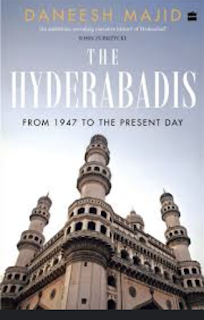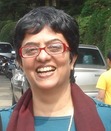Daneesh Majid: “History has mostly been written by those in power”

What struck me most about Daneesh Majeed’s book about whattranspired during princely Hyderabad’s integration into India in 1948, is itsparallels with the Sindh story. People did not consider their experiences worthdocumenting, eclipsed as it was by the much larger-scale violence elsewhere.Despite the dramatic lifestyle changes, colonization by dominant cultures,being sidelined in the administration and left to fend for themselves, theyfaced their plight with bravery and stoic acceptance. The book also exposescaricatures showcased through pop culture, media, and India’s many filmindustries.
Saaz: Why now, Daneesh? Whatgave you the courage to address this important piece of our history and theunjustifiably long gap in public discourse? And how did you approach writingabout that politically sensitive moment?
Daneesh: It wasn’t necessarily courage. An epiphany back in early 2020propelled me into action. A little before Covid, a video interview I conductedwith Arshad Pirzada crystallized something I had been thinking about whencarrying out some Hyderabad-centric features for The Hindu Business Line’sweekly magazine two years earlier. Pirzada is a former Gulf NRI whose familycame from a priestly lineage and had ties to the bureaucratic Asaf Jahiestablishment. Post-1948, they had to adjust to life as numerical minorities ina democratic landscape unlike the old feudal setup in which the ruling Muslimminority held sway. The hen Siasat.com chief editor, Ayoob AliKhan, chided both of us for not emphasizing this fall and rise aspect ofPirzada’s journey, one which included him becoming an economic migrant to SaudiArabia and paving the way for his family’s economic revival.
SThere are plenty of such stories in Hyderabad that have remainedundocumented (not only because many elders are no longer with us) and dilutedthrough generations. A lot of these accounts have not been brought to the forethrough crisp, timely and accessible narratives in the vein of works by authorslike Urvashi Butalia, Anam Zakaria, Aanchal Malhotra and yourself.
As for my approach, I could not solely rely on oral accounts.Besides my own enormous bookshelf, I scoured various bookstores, accessedpersonal libraries and found some academic articles to recreate the eras andbuild worlds that that the 11 different families lived in. My editor VikramShah’s nudges in the right direction were key to this.
Saaz: Hyderabad is a city ofsyncretism, but also of stark divides – linguistic, religious, and class-based.How did you navigate these complexities while telling its story?
Daneesh: Some of these divides existed pre-1948.
For instance, many people believe that the Mulki agitation whichbegan surfacing in the early 1950s was the earliest harbinger of theTelangana-Andhra divide. One story an acquaintance told me was about his father,a participant in the anti-Nizam and eventually anti-Indian government struggle.When his father was hiding out among Andhra Telugu cadres and interacting withordinary citizens during the late 40s in Bapatla, Madras Presidency, some ofthem either wondered how he was able to articulately communicate in Teluguwhile many poked fun at his Telangana dialect outright. That too, despite thefact that the Andhra Jana Sangham which helped foment revolt in Telanganabrought the Telugu populations from Madras Presidency and Telangana together onthe basis of language. He also spoke of how Andhraites monopolizeddecision-making out of a sense of organizational superiority.
So rather than only looking at these divisions throughpost-colonial, contemporary lenses, finding and citing primary/secondarysources that mention previous iterations of these divisions helped innavigating those present-day discords.
Saaz: Could you tell us about your mostimportant sources, and share any stories that surprised you or changed yourthinking?
Daneesh: Two important ones which altered specific notions come to mind—bothmy own and commonly held ones.
Dr. Rafiuddin Farouqui’s compilation of the Aurangabad (then apart of the Nizam state)-born Maulana Maududi’s letters, in which he beseechesQasim Razvi to negotiate the best terms of accession with the Indiangovernment. It showed a more farsighted, accommodating side to someone thatmany, including my own great-grandfather who served as a Director in theReligious Affairs Department of Princely Hyderabad, saw as a hardliner.
Chukka Ramaiah, the now 98-year-old activist who participated inthe early days of the Telangana Revolt not only abhorred the ruled Hindu vs.ruler Muslim angle of looking at the anti-Nizam struggle, but a cruder versionof the Andhra versus Telangana binary too. He was all praise for a class ofAndhraites who arrived in Hyderabad state during the early 50s, not asmonopolisers of the commercial and ruling dispensations. This group ofegalitarian-minded teachers from Andhra uplifted Telangana Telugus who previouslydidn’t have access to education, especially in their mother tongue.
Saaz: Our respective works (mine on theSindhis) trace the afterlives of two distinct but parallel communities deeplyaffected by the reshaping of India after Partition. What does this say abouthow we remember the ‘unwritten histories’ of India – the ones lived not bygovernments, but by people?
Daneesh: History has mostly been written by those in power. Today,various political figures have been rewriting history especially through theirelection rhetoric. Since 2018, state, municipal and national polls saw certainopposition factions referring to then Chief Minister KCR as the “New Nizam.” Theyrecasted national figures as reincarnations of the Iron Man who humbled OsmanAli Khan. The “Nizam culture” was blamed entirely for the city’s so-calledinability to become a global IT hub.
All this amounts to a constant rewriting of the past by thepowers that be as they evoke the powers that were! But it is the ordinary citizenryof today, the majority of which doesn’t have the time nor resources to (re)evaluatebygone eras, who gets polarized as a result. Cinema, social media reels andWhatsApp forwards, backed by a robust ecosystem don’t help either.
Yes, the Nizam possessed his shortcomings, and princelyHyderabad had a dark side to it. But this us-versus-them prism, with the Nizamand the Razakars being equated as the sole aggressors, has gained too muchcurrency.
I was told first and second-hand stories from Kayasthas andTelangana Hindus about Osman Ali Khan’s personal generosity and his patronageof temples. A lot of Telugu and Urdu literature chronicles how religiousMuslims took to the onset of leftism against a feudal set up spearheaded bytheir “own.”
Micro-histories that ask the “big” questions about historical occurrences, inthe “small” places are the need of the hour.
Saaz: Food, tehzeeb, language, architecture– Hyderabad’s cultural distinctiveness is legendary. Which elements do youthink are still thriving, and which are slipping away?
Daneesh: Shervanis as well as Rumi topis are still worn at weddings andvarious functions. The food for the most part is still around. The feudal mentalitythat makes things more hierarchical while also inducing inertia amongHyderabadis won’t disappear anytime soon. That being said, to varying extents,these elements certainly haven’t been immune to the onset of McDonaldization.
The Dakhani dialect, which isn’t in danger of being fullycannibalized by shuddh Hindi or khaalis Urdu yet,can still be heard widely. But the nastaleeq script in which one can readDakhani and standard Urdu literary gems, is rapidly fading away.
Signboards on streets as well as government offices and Urdu“jashns/anjumans” that often take place are in no way indicative of anysubstantive revival.
Unless the prose is translated, which to some is code for“diluted,” so much literature risks becoming obscure or an exotic relic of thepast. In the past three years, some of my favourite Old City bookstores haveclosed or aren’t selling non-religious content.
Saaz: Did you find yourself having to leavecertain things out – whether due to space, sensitivity, or complexity? Arethere stories you wish you’d been able to tell more fully?
Daneesh: Yes. Throughout my research and fieldwork, I learned of someinteresting reasons regarding why some Hyderabadis did or didn’t undertakelife-altering migrations to the West, the Gulf, other Indian cities, certainparts of Telangana/AP, or even Pakistan.
There are some intriguing anecdotes about why some Muslimsdecided to either stay in India or make the move to Pakistan. After 1948, eventhe apolitical, professional class of Hyderabad’s Muslims, regardless ofwhether they had ties to the nobility, considered settling in Pakistan. Despitethe 1965 War, which put spokes in the wheel of Indo-Pak travel, many left forPakistan in the 1970s out of personal grievances.
Including such sagas would have provided a more personal,interior context as to why people decided to leave their families and nativesoil. However, if an interviewee requests for the omission of any detail oranecdote, out of respect and sensitivity, I have to oblige.
Saaz: Who did you imagine asyour ideal reader while writing this book – and what do you hope they will takeaway from it?
Daneesh: My ideal reader was always someone who wants to lookat how people remember tragic episodes alongside common, sometimes militantlymainstreamed interpretations. Irrespective of whether the reader approaches myfirst book as such, at the very least, I hope that they get to experience theflavour of Hyderabad through its 11 diverse families. After all, a city’scultural distinctiveness isn’t only defined by its monuments, cuisine andlanguages, but also by those who call(ed) it home.
This interview was published in Hindustan Times on 10 Jun 2025.
https://www.hindustantimes.com/books/...



